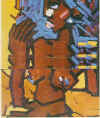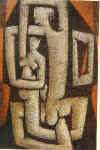| the-south-asian.com AUGUST 2001 | ||
| about us contact us data bank past issues the craft shop the print gallery | ||
|
SOCIETY & CULTURE Traditional
societies - Wisdom and Challenges SOUTH ASIAN FEATURE Hands
Across Borders INTERVIEW
Shantiniketan
and origin of Modern Art
Reinventing
India
Royal
Bengal's last roar?
|
Page 2
of 3
Modern Idiom in Contemporary Pakistani Art By Nillofur Farrukh
The Modernists
Zubeida Agha Zubeida Agha enjoys the distinction of the first artist to hold a solo
Modern Art exhibition in Pakistan. Held in Karachi in 1949, it kicked up a
storm of controversy with its radical interpretation of perspective and space.
A student of Sanyal and Mario Perlingieri, an Italian prisoner of war, Agha
was initially drawn to Surrealism. Her later education took place at St.
Martinís School of Art. On her return she settled in Rawalpindi, away from
the art centres of Lahore and Karachi. Here she continued to paint and support
the arts by setting up and running Contemporary Arts gallery. Her personal
style of painting alluded to child-like simplicity of form and a preference
for pure bright hues in the 1950s. Gradually her imagery became non-figurative
with colours and forms evocative of emotions and moods. Ali Imam Among the Lahore Artists Group, Ali Imam became an important art
educationist in Karachi. He was the architect of the modern curriculum of The
Central Institute of Arts and Crafts. In the 1970s he founded the Indus
gallery, to create a buyerís culture in the city where his student and peers
could sell art and make it a viable career. With all these preoccupations Ali
Imamís painting career took a back seat. Although he seldom paints, his work
remains in great demand. His technique transforms a realistic form into an
impressionistic image. Treated with outer layers of white pigment, an even
tone of subdued colours defines the costumes and features. He prefers to paint
groups of bulky humans in stiff postures. Ahmed Parvez Ahmed Parvez transferred his restless energy on the canvas with a burst of
colour and exploding forms. His early figurative art turned abstract during
the decade he spent in England from 1955 to 1964. There he became inspired by
Alan Davie but developed his own distinct style. His exhibitions were well
received in London. On the occasion of his show of abstract miniatures, the
critic for The Guardian wrote, "The mood is near Klee as it is to the
jewelled ambience of an eastern potentate". Ahmed Parvez influenced the
Karachi art scene in the 1970s both with his personality and art. An
uncompromising professional, he was a spiritual mentor to the younger
generation and a fierce critic of his peers. His volatile, impatient nature
brought him tragedy in personal life, which drove him to ill health and an
early death. Ahmed Parvez continued to paint till the end and has left behind
a large body of work. In 1978, a year before his death, he was recognised as
one of the countryís outstanding artists and awarded the Pride of
Performance. Anwar Jalal Shemza A 1947 graduate of the Mayo School of Art, Anwar Jalal Shemza was also
among the pioneer modernists. He settled in England but continued to hold
regular exhibitions in Pakistan. Geometric patterns entwined with forms
inspired from Arabic calligraphy in vibrant colours dominated his later work. Guljee It was his exposure to Action painting that motivated Guljee to turn to
gestural painting. Over the years he incorporated Arabic calligraphy and
textured his works with gold leaf and lapis. His latest most prestigious
commission was for the Shah Faisal Mosque in Islamabad.
Copyright © 2000 - 2001 [the-south-asian.com]. Intellectual Property. All rights reserved. |
|


